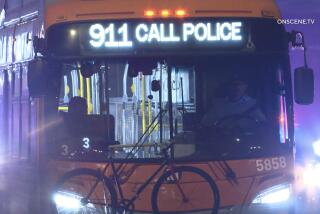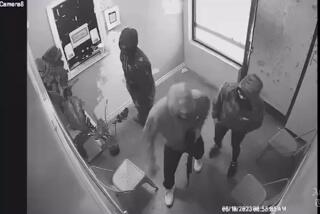Concern for Trolley Security Rises : Transportation: Officials examine options in wake of violence along systemâs East Line.
Transit officials reacted grimly Monday to new violence involving the San Diego Trolley, especially the East Line, where a shooting and an unrelated robbery occurred Sunday night.
The latest incidents sparked new concerns about neighborhoods along the East Line, which runs through some of the roughest areas of Logan Heights and Southeast San Diego as it takes riders between downtown San Diego and El Cajon.
Shortly after 7 p.m. Sunday, two men and a woman robbed an East Line passenger on one of the cars, taking his wallet and inflicting minor injuries, police said. Three suspects were arrested soon after getting off the trolley at 12th and Imperial avenues.
Fifteen minutes later, a dispute between a black man and two Latino men led to a shooting in which the Latinos were struck by bullets from a .22-caliber rifle near the trolley station at 25th and Commercial streets, police said. It was unclear whether the men were trolley passengers.
The incidents follow a pair of attacks last month that left one passenger dead and two slightly injured along the line. In one incident a rock thrown by a gang member struck a young woman in the head and killed her near the 32nd Street station, police said. Her companion was injured.
âAlthough one of the (Sunday) incidents involved a shooting, Iâm particularly concerned about anyone being accosted while riding one of our cars,â James R. Mills, chairman of the Metropolitan Transit Development Board, said Monday. âOur service has been remarkably free of that kind of crime. Thatâs upsetting.â
The debate over trolley security is complicated by shrinking funds, which could decrease further if state lawmakers approve $150 million in transportation cuts, Mills said.
Mills called the threatened budgets cuts âa crisisâ and said security, along with dozens of other transit-related services, would be immediately put in jeopardy.
Mills said the funds were tied to revenue approved in the Transit Development Act as far back as 1971. Mills said a major cut of the funds would have an even more crippling effect, since services would have to be cut, reducing fare-box revenues as well.
âItâs got the transit industry hysterical,â he said, noting that an âemergencyâ meeting of the California Transit Assn. has been called for Wednesday. If the cuts are enacted, he predicted a 25% reduction in services âacross the board.â
Sacramentoâs threats come at an especially bad time for San Diego Trolley Inc., and the MTDB, which have been wrestling with a solution to increased violence near East Line stations.
Mills said a proposal to have sheriffâs deputies take over security on and near the trolley remains âa possibility,â although negotiations between the Sheriffâs Department and transit officials have temporarily broken down.
During negotiations between April and June, Undersheriff Jay LaSeur proposed that the Sheriffâs Department could take over trolley security for about $2 million a year--or roughly the same amount spent on the trolley systemâs 32-member private security team and 22 fare-enforcement officers.
Trolley officials said the proposal was never formally submitted to either the trolley board or MTDB because of an inability to guarantee jobs in other locations for the fare officers.
But Mills said the idea is far from dead: âIt hasnât come to anything yet, but Iâm not sure at all that it wonât. It has a number of attractive elements, one being that sheriffâs deputies have the power to make arrests and make whatever they do stick. So the issue isnât closed.â
Peter Tereschuck, the vice president of transportation for San Diego Trolley Inc., said Monday that the âperceptionâ of crime on the trolley is worse than the actual numbers, and he argued that San Diegoâs light-rail system is among the safest in the country.
Even so, Tereschuck said, transit officials have spent an additional 36% on security, the amount jumping from $780,000 in fiscal year 1991 to the current $1.275 million.
Tereschuck conceded that the East Line poses a greater risk than the South Line, which travels from downtown to the international border in San Ysidro. The South Line has had problems but not as many as the East Line, he said.
Increased crime is ânot a trolley problem, per se, but more a societal problem, and clearly, weâre victimized,â Tereschuck said. âTo some extent, it falls on our shoulders. Weâre not satisfied that any crime occurs on or near the system.â
But Tereschuck noted that most crime occurs, not on the cars themselves, but at or near the stations, sometimes blocks away. The word trolley often filters into the police report, he said, only because an officer used it to identify a location.
âI understand the geographical connection, but sometimes it renders a misleading impression when applying the word trolley to such a story,â he said.
In the case of the recent homicide, Tereschuck said the young woman left the trolley to relieve herself in a field near the 32nd Street station. As she was walking back to re-board the trolley, she and her companions were set upon by gang members, Tereschuck said.
âEverybody is saying, âIf the trolley had more security, this wouldnât have happened,â but we can hardly be held accountable once people leave our system,â Tereschuck said. âWe are in some cases every bit as much a victim of crime as local communities are.
âWhile we do what we can to control it, there are limits to what we can do--based not only on limited authority but also on limited resources.â
Tereschuck said the system now has 30 armed security guards, two plainclothes officers and 22 fare officers, who are authorized to write citations.
Critics of trolley security say the current contingent lacks enforcement powers and is hampered by slow backup protection and lack of radios. Some guards have complained about having to call for help by using the pay phones at stations.
More to Read
Sign up for Essential California
The most important California stories and recommendations in your inbox every morning.
You may occasionally receive promotional content from the Los Angeles Times.










